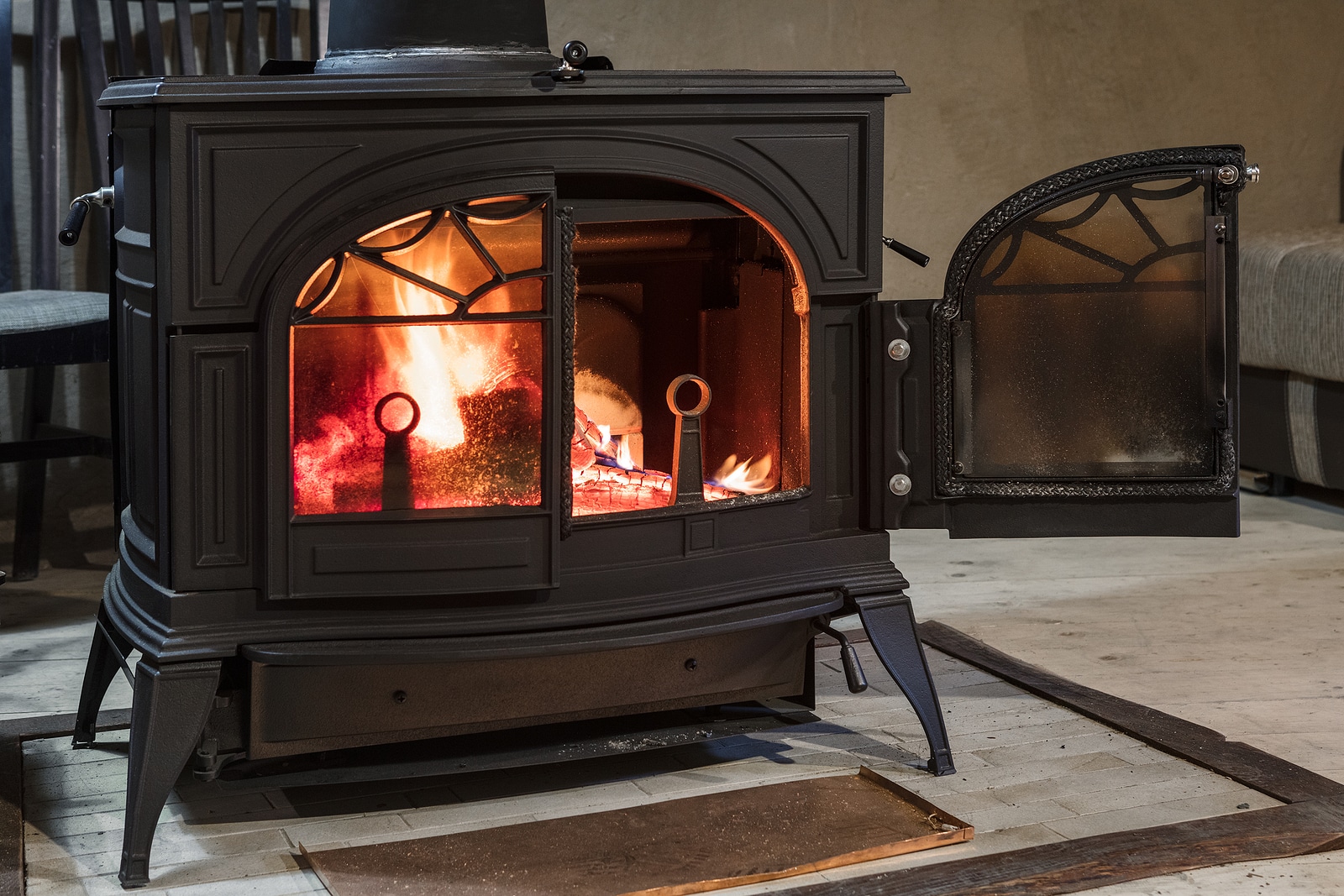How To Install A Wood Stove In A Garage

Are you looking to install a wood stove in your garage? That’s a fantastic idea for creating a cozy and warm space during the chilly winter months! To get started, follow these simple steps. First, make sure you have a suitable location for your wood stove in the garage. Look for an area that is well-ventilated and away from any flammable materials. Next, gather all the necessary materials and tools, such as a wood stove, chimney pipe, and a fire-resistant hearth pad. Measure the space where you plan to install the wood stove and ensure it meets the safety regulations. Then, carefully assemble the chimney pipe, following the manufacturer’s instructions. Once everything is prepared, it’s time to connect the chimney pipe to the wood stove and secure it in place. Lastly, test the stoves’ functionality and enjoy the warmth of your new wood stove in your garage. Stay warm and safe!
Understanding the Basics
The Importance of Installing a Wood Stove
Installing a wood stove in your garage can provide numerous benefits. Not only does it serve as a reliable heat source during the colder months, but it also allows you to extend the usable space in your garage throughout the year. Whether you plan to use your garage as a workshop, a place to store your vehicles, or even as a cozy hangout spot, a wood stove will ensure that you can comfortably enjoy your space no matter the weather outside.
Possible Risks and Safety Measures
Before embarking on the installation process, it’s essential to be aware of the potential risks associated with installing a wood stove in a garage. The primary concern is the risk of fire if the stove is not installed or maintained properly. This is why it is crucial to follow all safety guidelines and regulations during every step of the installation process. Additionally, it’s important to have proper ventilation to prevent the build-up of carbon monoxide, a colorless and odorless gas that can be extremely dangerous if not properly vented.
Knowing the Basic Requirements
To ensure a successful installation, there are a few basic requirements that you should be aware of. First and foremost, you will need enough space in your garage to accommodate the wood stove and the necessary clearances for safe operation. It is also essential to have a suitable location for the stove that allows for proper ventilation. Additionally, you’ll need to have access to the right tools and materials to complete the installation. Finally, it’s important to understand the local building codes and regulations that may apply to wood stove installations in your area.
Required Tools and Materials
List of Tools Needed for the Installation
To install a wood stove in your garage, you will need a variety of tools. Some of the essential tools include a tape measure for accurate measurements, a level to ensure the stove is installed correctly, a drill for making holes, a reciprocating saw for cutting through walls if necessary, and a wrench for tightening bolts. Additionally, you may also require other tools such as a caulk gun, a wire brush, and a chimney brush for maintenance purposes.
Materials Required to Complete the Installation
In addition to the necessary tools, you will also need a range of materials to successfully install a wood stove in your garage. These materials include stove pipe sections, chimney pipes, elbows and adapters, chimney cap, high-temperature sealant, fire-resistant base materials, and appropriate fasteners. It’s important to select materials that are compatible with a wood stove installation and meet all safety requirements.
Where to Source the Tools and Materials
The tools and materials needed for a wood stove installation can be sourced from various places. Home improvement stores, local hardware stores, and specialized fireplace and chimney suppliers are excellent sources for most of the tools and materials required for the installation. Additionally, online retailers offer a wide selection of products, making it convenient to compare prices and find unique or hard-to-find items. It’s important to ensure that all tools and materials are of high quality and meet the necessary safety standards for wood stove installations.
Choosing the Right Wood Stove
Assessing Your Heating Needs
When selecting a wood stove for your garage, it’s essential to assess your heating needs. Consider the size of the space you intend to heat, the insulation of the garage, and the climate in your area. This information will help you determine the heating capacity required from your wood stove. It’s always better to choose a stove with a slightly higher heating capacity than you think you’ll need to ensure optimal comfort during colder temperatures.
Selecting the Size of the Stove
The size of the stove is also an important factor to consider. A stove that is too small may struggle to heat your garage adequately, while a stove that is too large can lead to wasted energy and excessive heat. To determine the appropriate size, consider the square footage of the area you plan to heat and consult the manufacturer’s guidelines or seek the advice of a professional.
Comparing Different Models
Once you have assessed your heating needs and determined the appropriate size, it’s time to compare different wood stove models. Look for stoves that are energy-efficient, have good reviews, and are known for their reliability. Consider additional features such as air wash systems for cleaner glass, secondary combustion for increased efficiency, and ash management systems for easier maintenance. Be sure to also compare prices and warranties offered by different manufacturers to make an informed decision.
Preparing the Installation Area
Determining the Location of the Stove
Before installing a wood stove, you need to carefully choose its location in your garage. It’s essential to select a position that allows for proper clearances from walls, ceilings, and flammable objects. The stove should be centrally located to ensure even heat distribution throughout the space. Consider your garage’s configuration and any other potential obstructions that may affect the stove’s installation.
Clearing and Cleaning the Space
Once you have determined the location of the stove, it’s necessary to clear and clean the area. Remove any debris, combustible materials, or potential fire hazards from the vicinity. Clean the floor to ensure there is no dirt or dust that could interfere with the installation process or pose a risk to the operation of the wood stove.
Setting Up the Necessary Ventilation
Proper ventilation is crucial when installing a wood stove in a garage. You will need to install a vent pipe that connects the stove to the exterior. Ensure that the vent pipe is positioned correctly and that it meets all local building codes and regulations. This will help to safely exhaust the combustion gases produced by the wood stove and prevent the build-up of harmful carbon monoxide inside your garage.
Creating a Non-Combustible Base for the Stove
Selecting a Suitable Material for the Base
To provide a safe and stable foundation for your wood stove, it’s necessary to create a non-combustible base. Common materials used for this purpose include fire-resistant bricks, concrete pavers, or stove boards made from ceramic or metal. Make sure the chosen material is thick enough to withstand the high temperatures generated by the stove and complies with safety regulations.
Measuring and Cutting the Material
Once you have chosen the material for the base, measure the dimensions required for the stove’s footprint. Use a tape measure and mark the specific dimensions on the material. Use a circular saw or a jigsaw to make precise cuts according to the measurements. Take extra care to ensure the edges are smooth and free of any sharp or uneven areas.
Assembling and Securing the Base
After cutting the material to the appropriate size, assemble the pieces to create the base. If using fire-resistant bricks or concrete pavers, arrange them in a pattern that ensures stability and durability. If using a stove board, follow the manufacturer’s instructions for assembly. Once assembled, secure the base to the floor using appropriate fasteners or adhesives to prevent any movement during the stove’s operation.
Installing the Stove
Answering the Stove on the Base
With the non-combustible base in position, carefully lift the wood stove and place it on top of the base. Ensure that the stove is centered and level. Adjust the stove’s feet or base if necessary to achieve an even balance. Confirm that the stove is stable before proceeding with the installation process.
Connecting the Stove to the Flue Pipe
The next step is to connect the wood stove to the flue pipe, which directs the combustion gases outside. Make sure to use the appropriate size and type of stove pipe sections, elbows, and adapters as recommended by the manufacturer. Connect the stove pipe sections securely, ensuring a tight seal to prevent any air leakage or the escape of combustion gases.
Sealing the Connections with High-Temperature Sealant
To ensure the safety and efficiency of the wood stove installation, seal all connections between the stove and the flue pipe using high-temperature sealant. Apply the sealant generously around the joints of the stove pipe sections, elbows, and adapters. This will prevent any smoke or toxic gases from escaping and ensure that the entire system operates smoothly.
Installing the Chimney
Deciding on the Route of the Chimney
Before installing the chimney pipe, it’s essential to decide on the route it will take to exhaust the combustion gases safely. Consider the best path that allows for sufficient clearance from combustible materials and ensures easy access for cleaning and maintenance. Consult local building codes and regulations to ensure compliance with any specific requirements for the chimney installation.
Cutting a Hole for the Chimney Exit
Using appropriate tools, carefully cut a hole in the wall or ceiling for the chimney’s exit point. The size of the hole should match the diameter of the chimney pipe. Take utmost care to ensure the hole is accurately positioned, level, and straight to facilitate a proper and secure connection between the chimney pipe and the vent pipe from the stove.
Installing the Chimney Pipe
Once the hole is cut, install the chimney pipe by attaching it securely to the vent pipe from the wood stove. Ensure that the connections are airtight and free from any gaps or leaks. If multiple sections of chimney pipe are required, follow the manufacturer’s instructions for proper assembly and secure all sections with appropriate fasteners.
Equipping the Smoke Alarm and Carbon Monoxide Detector
Choosing the Right Alarm and Detector
Safety should be a top priority when installing a wood stove in your garage. Install a smoke alarm and a carbon monoxide detector to provide early warnings in case of fire or the presence of harmful gases. Select alarm and detector units specifically designed for residential use and that meet the necessary safety standards and certifications.
Deciding on the Placement
Proper placement of the smoke alarm and carbon monoxide detector is crucial to ensure they function effectively. Install the smoke alarm on the ceiling or high on a wall, following the manufacturer’s instructions for optimal placement. Additionally, position the carbon monoxide detector at a height where it can easily detect any potential carbon monoxide accumulation. Consult the instructions for specific details on placement guidelines.
Installing the Alarm and Detector
Using appropriate hardware, install the smoke alarm and carbon monoxide detector securely to the wall or ceiling. Ensure that they are within the recommended distance from the wood stove and properly positioned for optimal coverage. Regularly test the batteries and functionality of these devices to ensure they are operational and provide the necessary protection.
Initial Use of the Wood Stove
Understanding Proper Operation of a Wood Stove
Before you start using your newly installed wood stove, it’s vital to familiarize yourself with its proper operation. Read the manufacturer’s instructions and guidelines for operating the stove safely and efficiently. Understand how to adjust the air vents, load the firebox with wood, and control the heat output. Follow all recommended practices to ensure a clean and efficient burn.
Burning Initial Fires
To ensure the longevity and optimal performance of your wood stove, it’s important to burn initial fires correctly. Start by burning small, hot fires for the first few times, gradually increasing the size of the fire as the stove becomes seasoned. This process helps to cure the stove, removes any residual manufacturing oils or coatings, and minimizes the risk of cracks or other damage.
Checking for Leaks or Problems
After the initial fires, closely monitor the wood stove and surrounding areas for any signs of leaks or problems. Look for smoke or soot buildup around the stove, chimney, or vent pipe connections. Pay attention to any unusual smells or sounds that may indicate a problem. Regularly inspect all components of the wood stove installation to identify issues early on and address them promptly.
Regular Maintenance and Safety
How to Properly Maintain a Wood Stove
Regular maintenance is essential to ensure the safe and efficient operation of a wood stove. Follow the manufacturer’s guidelines for cleaning and maintaining your specific model. This typically involves regularly removing ashes, cleaning the stove pipes and chimney, inspecting gaskets and seals for wear and tear, and checking for any signs of damage or deterioration. Proper maintenance will prolong the life of your wood stove and prevent potential issues.
Checklist for Regular Safety Checks
To keep your wood stove installation safe, it’s important to perform regular safety checks. Create a checklist that includes inspecting the stovepipe connections, examining the chimney for debris or blockages, testing the smoke alarm and carbon monoxide detector, and ensuring proper clearances from combustible materials. Schedule these safety checks at regular intervals throughout the year to maintain a safe and well-functioning wood stove.
Troubleshooting Common Issues
Even with regular maintenance and proper use, occasional issues may arise with your wood stove installation. Troubleshooting common problems such as excess smoke, difficulty in starting a fire, or poor heat distribution can often be resolved with simple solutions. Consult the manufacturer’s troubleshooting guide or seek advice from a professional if you encounter any persistent or more complex issues that require expert assistance.
By following these comprehensive guidelines, you can successfully install a wood stove in your garage while ensuring the necessary safety measures are in place. Enjoy the warmth, comfort, and versatility that a wood stove brings to your garage space all year round. Stay cozy and safe!


